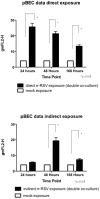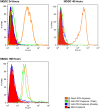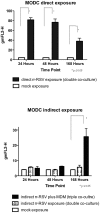Macrophages are required for dendritic cell uptake of respiratory syncytial virus from an infected epithelium
- PMID: 24651119
- PMCID: PMC3961264
- DOI: 10.1371/journal.pone.0091855
Macrophages are required for dendritic cell uptake of respiratory syncytial virus from an infected epithelium
Abstract
We have previously shown that the respiratory syncytial virus [RSV] can productively infect monocyte derived dendritic cells [MoDC] and remain dormant within the same cells for prolonged periods. It is therefore possible that infected dendritic cells act as a reservoir within the airways of individuals between annual epidemics. In the present study we explored the possibility that sub-epithelial DCs can be infected with RSV from differentiated bronchial epithelium and that in turn RSV from DCs can infect the epithelium. A dual co-culture model was established in which a differentiated primary airway epithelium on an Air Liquid Interface (ALI) was cultured on a transwell insert and MoDCs were subsequently added to the basolateral membrane of the insert. Further experiments were undertaken using a triple co-culture model in which in which macrophages were added to the apical surface of the differentiated epithelium. A modified RSV [rr-RSV] expressing a red fluorescent protein marker of replication was used to infect either the MoDCs or the differentiated epithelium and infection of the reciprocal cell type was assessed using confocal microscopy. Our data shows that primary epithelium became infected when rr-RSV infected MoDCs were introduced onto the basal surface of the transwell insert. MoDCs located beneath the epithelium did not become infected with virus from infected epithelial cells in the dual co-culture model. However when macrophages were present on the apical surface of the primary epithelium infection of the basal MoDCs occurred. Our data suggests that RSV infected dendritic cells readily transmit infection to epithelial cells even when they are located beneath the basal layer. However macrophages appear to be necessary for the transmission of infection from epithelial cells to basal dendritic cells.
Conflict of interest statement
Figures








Similar articles
-
Respiratory syncytial virus can infect basal cells and alter human airway epithelial differentiation.PLoS One. 2014 Jul 17;9(7):e102368. doi: 10.1371/journal.pone.0102368. eCollection 2014. PLoS One. 2014. PMID: 25033192 Free PMC article.
-
Persistent of respiratory syncytial virus in human dendritic cells and influence of nitric oxide.Clin Exp Immunol. 2008 Feb;151(2):359-66. doi: 10.1111/j.1365-2249.2007.03560.x. Epub 2007 Dec 6. Clin Exp Immunol. 2008. PMID: 18062796 Free PMC article.
-
Differentiation and immune function of human dendritic cells following infection by respiratory syncytial virus.Clin Exp Immunol. 2006 Mar;143(3):513-22. doi: 10.1111/j.1365-2249.2005.03004.x. Clin Exp Immunol. 2006. PMID: 16487251 Free PMC article.
-
Respiratory syncytial virus interaction with human airway epithelium.Trends Microbiol. 2013 May;21(5):238-44. doi: 10.1016/j.tim.2013.02.004. Epub 2013 Mar 22. Trends Microbiol. 2013. PMID: 23523320 Review.
-
Advances in understanding respiratory syncytial virus infection in airway epithelial cells and consequential effects on the immune response.Microbes Infect. 2013 Mar;15(3):230-42. doi: 10.1016/j.micinf.2012.11.012. Epub 2012 Dec 12. Microbes Infect. 2013. PMID: 23246463 Review.
Cited by
-
Innate Immune Components that Regulate the Pathogenesis and Resolution of hRSV and hMPV Infections.Viruses. 2020 Jun 12;12(6):637. doi: 10.3390/v12060637. Viruses. 2020. PMID: 32545470 Free PMC article. Review.
-
Alveolar Macrophages Treated With Bacillus subtilis Spore Protect Mice Infected With Respiratory Syncytial Virus A2.Front Microbiol. 2019 Mar 12;10:447. doi: 10.3389/fmicb.2019.00447. eCollection 2019. Front Microbiol. 2019. PMID: 30930867 Free PMC article.
-
Small airway-on-a-chip enables analysis of human lung inflammation and drug responses in vitro.Nat Methods. 2016 Feb;13(2):151-7. doi: 10.1038/nmeth.3697. Epub 2015 Dec 21. Nat Methods. 2016. PMID: 26689262
-
Airway epithelium in lung transplantation: a potential actor for post-transplant complications?Eur Respir Rev. 2024 Nov 27;33(174):240093. doi: 10.1183/16000617.0093-2024. Print 2024 Oct. Eur Respir Rev. 2024. PMID: 39603662 Free PMC article. Review.
-
Respiratory Syncytial Virus-Infected Mesenchymal Stem Cells Regulate Immunity via Interferon Beta and Indoleamine-2,3-Dioxygenase.PLoS One. 2016 Oct 3;11(10):e0163709. doi: 10.1371/journal.pone.0163709. eCollection 2016. PLoS One. 2016. PMID: 27695127 Free PMC article.
References
-
- Hall CB, Geiman JM, Biggar R Kotok DI, Hogan PM, et al. (1976) Respiratory syncitial virus infections within families. N Engl J Med 294: 4l4–419. - PubMed
-
- Everard ML (2009) Respiratory syncytial virus bronchiolitis and pneumonia. In Textbook of Paediatric Respiratory Medicine eds Taussig L, Landau L. Mosby St.Louis 2nd ed 491–499.
-
- Everard ML (2006) The role of the respiratory syncytial virus in airway syndromes in childhood. Curr Allergy Asthma Rep 6: 97–102. - PubMed
-
- Parrott RH, Kim HW, Arrobio JO, Hodes DS, Murphy BR, et al. (1973) Epidemiology of respiratory syncitial virus infections in Washington DC II. Infection and disease with respect to age, immunological status, race and sex. Am J Epidemiol 98: 289–300. - PubMed
Publication types
MeSH terms
LinkOut - more resources
Full Text Sources
Other Literature Sources
Medical

